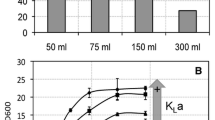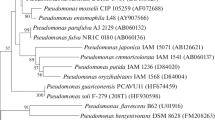Abstract
Pseudomonas testosteroni metabolized 4-hydroxycinnamate by an initial cleavage of the side chain to yield acetate and the aromatic moiety, 4-hydroxybenzaldehyde. The latter was further oxidized via 4-hydroxybenzoate to protocatechuate, which underwent meta cleavage. During growth of the organism on 4-hydroxycinnamate, the \(Q_{O_2 } ^{\max } \) for acetate showed an undulating pattern, which was attributed to alternating induction and repression of enzymes involved in the oxidation of acetate. Repression was caused either by 4-hydroxybenzoate or by its later metabolites, formate and pyruvate.
In batch culture, P. testosteroni oxidized mixtures of 4-hydroxybenzoate and 4-hydroxycinnamate in a diauxic pattern. The capacity to oxidize 4-hydroxycinnamate appeared in the cells before 4-hydroxybenzoate was exhausted, indicating that the enzymes catalysing the conversion of 4-hydroxycinnamate into 4-hydroxybenzoate. were induced despite the presence of 4-hydroxybenzoate. The induction of these early enzymes of 4-hydroxycinnamate catabolism started when the molar concentration ratio of 4-hydroxybenzoate to 4-hydroxycinnamate fell below a value of 0.3.
In continuous culture of P. testosteroni on a mixture of 4-hydroxybenzoate and 4-hydroxycinnamate, both substrates were almost completely utilized up to a dilution rate of about 0.5/h. At higher dilution rates, 4-hydroxycinnamate was decreasingly utilized so that eventually at a dilution rate of 0.74/h, its effluent concentration equalled its influent concentration. At D M, a utilization ratio of 1.23 in favour of 4-hydroxybenzoate was found to become established in the culture. The \(Q_{O_2 } ^{\max } \) of the cells for acetate was maximal at a dilution rate of 0.38/h and decreased before 4-hydroxycinnamate utilization was at its peak at 0.59/h. This suggested that it was mainly the aromatic moiety of 4-hydroxycinnamate which was metabolized at high dilution rates. The failure to utilize acetate at high dilution rates was apparently due to the repression of its catabolic enzymes by later metabolites of 4-hydroxybenzoate and to the relatively low concentration of acetate in the fermenter. This low concentration, due to the continuous washout of acetate, prevented it from relieving the repression.
Similar content being viewed by others
Abbreviations
- 4HB:
-
4-hydroxybenzoate
- 4HC:
-
4-hydroxycinnamate
- D M :
-
dilution rate allowing maximal cell output rate
- OD:
-
optical density
References
Drews, G.: Mikrobiologisches Praktikum für Naturwissenschaftler. Berlin-Heidelberg-New York: Springer 1968
Higgins, S. J., Mandelstam, J.: Regulation of pathways degrading aromatic substrates in Pseudomonas putida. Enzymic response to binary mixtures of substrates. Biochem. J. 126, 901–916 (1972)
Holding, A. J., Collee, J. G.: Routine biochemical tests. In: Methods in microbiology, Vol. 6A (J. R. Norris, D. W. Ribbons, eds.), pp. 1–32. London-New York: Acad. Press 1971
Marcus, J., Talalay, P.: Induction and purification of α- and β-hydroxy-steroid dehydrogenases. J. Biol. Chem. 218, 661–674 (1956)
Paigen, K., Williams, B.: Catabolite repression and other control mechanisms in carbohydrate utilization. Adv. Microbial Physiol. 4, 251–324 (1970)
Park, D.: Survival of microorganisms in soil. In: Ecology of soilborne plant pathogens. (K. F. Baker, W. C. Snyder, eds.). Berkeley-Los Angeles: University of California Press 1965
Pochon, J., Tardieux, P.: Techniques d'analyse en microbiologie du sol. St. Mandé (Seine): Editions de la Tourelle 1962
Reber, H.: Comparative studies with two pseudomonads on the sequential degradation of aromatic substances metabolized via different pathways. Arch. Mikrobiol. 89, 305–315 (1973)
Reber, H.: Regulation of amino acid and glucose dissimilation in socalled ammonifiers and in other soil microorganisms. Arch. Microbiol. 101, 247–258 (1974)
Reber, H.: Investigation on the sequential degradation of aromatic substances in pseudomonads. In: Biodégradation et humification (G. Kilbertus, O. Reisinger, A. Mourrey, J. A. Cancela da Fonseca eds.), pp. 466–469, Sarreguémines: Pierron 1975
Rose, I.: Acetate kinase of bacteria (acetokinase). In: Methods in enzymology, Vol. 1 (S. P. Colowick, N. O. Kaplan, eds.), pp. 591–595. New York: Acad. Press 1955
Silver, R. S., Mateles, R. I.: Control of mixed-substrate utilization in continuous cultures of Escherichia coli. J. Bacteriol. 97, 535–543 (1969)
Stanier, R. Y., Palleroni, N. J., Doudoroff, M.: The aerobic pseudomonads: a taxonomic study. J. Gen. Microbiol. 43, 159–271 (1966)
Toms, A., Wood, J. M.: The degradation of trans-ferulic acid by Pseudomonas acidovorans. Biochemistry 9, 337–343 (1970)
Author information
Authors and Affiliations
Rights and permissions
About this article
Cite this article
Karanth, N.G.K., Reber, H. Regulation of the utilization of 4-hydroxybenzoate and 4-hydroxycinnamate in batch and continuous cultures of Pseudomonas testosteroni . Arch. Microbiol. 120, 97–103 (1979). https://doi.org/10.1007/BF00409095
Received:
Issue Date:
DOI: https://doi.org/10.1007/BF00409095




